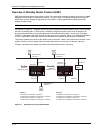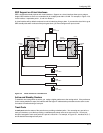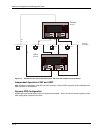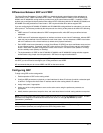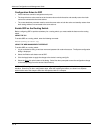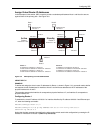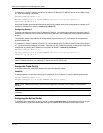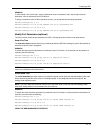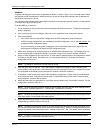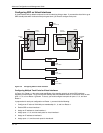
Configuring SRP
Differences Between SRP and VRRP
The Virtual Router Redundancy Protocol (VRRP) is a standards-based protocol that provides redundancy to
routers within a LAN. VRRP is described in RFC 2338. The implementation of VRRP on the HP 9304M, HP
9308M, and HP 6308M-SX routing switches provides many of the same features as SRP. In addition, VRRP
enables you to configure third-party devices that adhere to RFC 2338 along with the HP 9304M, HP 9308M, and
HP 6308M-SX routing switches as virtual routers. SRP requires that the other devices support SRP.
If you are configuring the HP 9304M, HP 9308M, and HP 6308M-SX routing switches for redundancy, you can use
either protocol. The features provided by the two protocols are similar, yet the protocols do differ in the following
ways:
• VRRP uses an IP multicast address for VRRP management traffic, while SRP uses pre-defined unicast
addresses.
• VRRP uses real IP addresses assigned to an interface and does not use virtual IP addresses, whereas SRP
must use one pre-defined virtual IP address for each virtual router. You can associate a VRRP virtual router
with an IP address or with a virtual interface (a named set of physical interfaces).
• Each VRRP virtual router (denoted by a unique Virtual Router ID [VRID]) can have one Master router and one
or more Backup routers. In contrast, each SRP router can have one Primary Router and only one Standby
Router. Most VRRP and SRP configurations consist of two routers—one active router (Master or Primary)
and one standby router (Backup or Standby).
• The implementation of VRRP on the HP 9304M, HP 9308M, and HP 6308M-SX routing switches supports
authentication using simple clear text passwords. SRP does not support authentication.
NOTE: If your routing switches already are using SRP and you do not need redundancy with devices that cannot
use SRP, you do not need to reconfigure your routing switches to use VRRP.
HP recommends that you do not use VRRP and SRP on the same device.
Configuring SRP
To begin using SRP on the routing switch:
1. Enable operation of SRP on the routing switch.
2. Configure SRP parameters on physical or virtual interfaces for those IP sub-nets for which a redundant path
is desired. Configure the virtual router IP address and the other routing switch’s IP address.
3. Assign track ports, if appropriate.
4. Assign one of the routing switches to serve as the active router using the preference parameter, as
appropriate.
5. Modify interface parameters, keep-alive-time, and router-dead-interval on both routing switches as required.
NOTE: You initially enable SRP at the global CONFIG level of the CLI using the router srp command. All other
parameters are assigned or modified at the interface level of the CLI using ip srp address <ip-addr>
[<parameter>] commands.
NOTE: If you are using the Web Management interface, you enable SRP on the System configuration sheet. All
other parameters (interface) are configured on the SRP configuration sheet.
13 - 7






